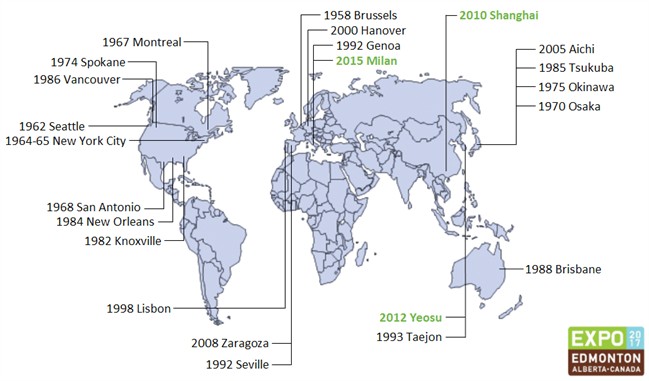EXPO History
 Imagine a medieval market place. A souk in ninth-century Arabia. Places that drew people from hundreds of miles away, by ship, by foot, by camel or horse. To trade goods and to trade ideas. This is the genesis of EXPO. Learn about EXPO history at EXPO Museum.
Imagine a medieval market place. A souk in ninth-century Arabia. Places that drew people from hundreds of miles away, by ship, by foot, by camel or horse. To trade goods and to trade ideas. This is the genesis of EXPO. Learn about EXPO history at EXPO Museum.
The first world exhibition was held in London, England in 1851. To this day the principle behind EXPO, the trading of ideas, remains the same.
Vancouver 1986
The most successful EXPO of the 20th century, and the last held in North America. The theme was "World in motion - World in touch." There were 2 theme pavilions: looking at how transportation has evolved, and futuristic vehicles. And a special pavilion displayed the treasures of Egyptian pharaoh Ramses II.
But one of the most popular was the Northwest Territories pavilion, designed with light blue plaster and glass to imitate icebergs and glaciers. The exhibits detailed the dramatic effects of transportation and communications on the life of northern Canadians.
EXPO 86 brought Vancouver on to the world stage in style.
Montreal 1967
EXPO came to Canada in style, the largest exhibition on the continent. The theme, "Man and his World," meant lively exhibits attracting record numbers of visitors. The highlight was the Gyrotron: it took you into the throat of a volcano with sound and light effects. And Edmonton was there. A replica of Fort Edmonton brought the Wild West to town, along with some of its disrepute: a striptease in the saloon.
The exhibition was beset by financial problems and cost over-runs. But the major infrastructure investment paid off in the long term for Montreal.
New York 1939-1940
America's corporate giants showed off the latest advances in technology to improve our daily lives: robots and remote controlled machines. Cars, now central to the American dream, featured prominently. The largest pavilions were built by the 3 big car manufacturers. And electricity was the other story, with the Singing Tower of Light.
The US had not yet entered World War II. But the effects of the war were felt in the second exhibition of 1940. People flocked to the Polish pavilion, to hear firsthand accounts of the war, and were given photos of the German Wehrmacht's destruction of Poland.
Philadelphia 1876
The first Great World Exhibition held in North America. It established the United States as a major industrial power.
For the first time people got to see Alexander Bell's telephone, a sewing machine, and a functioning typewriter.
The exhibition offered other firsts: a women's pavilion, for and by women, and an international art exhibition, including sculptures, paintings and photographs.
London 1851
The first EXPO was held in London's Hyde Park at the Crystal Palace, a grandiose take on English conservatories. Half the exhibition space was taken up by Great Britain and her colonies.
Machines in motion were the star attractions. Industrialized countries showed off the latest steam engines. The colonies brought raw materials, exotic art and stuffed animals most Europeans had never encountered.
Europe's revolutions formed the political back-drop. So the Royal Commission made sure the exhibition was cheap and accessible to everyone. Thousands flocked from around the British Isles and Europe. Queen Victoria wrote in her diary after the opening, "This day is one of the greatest and most glorious in our lives."

































